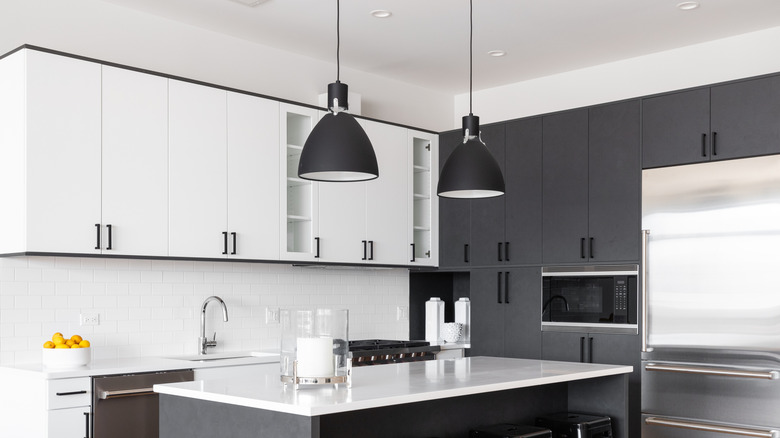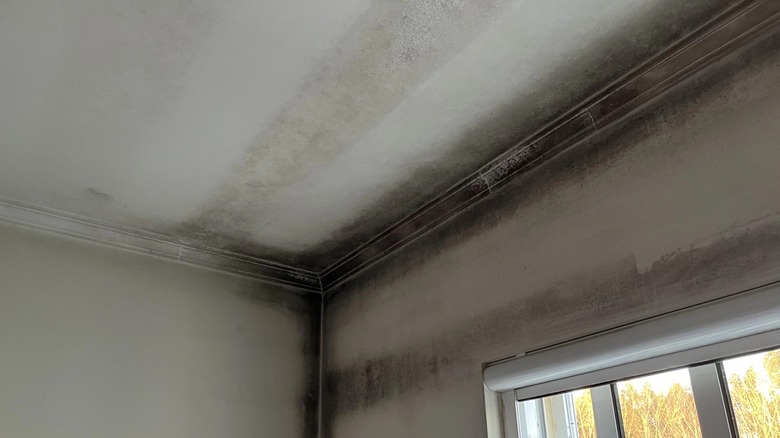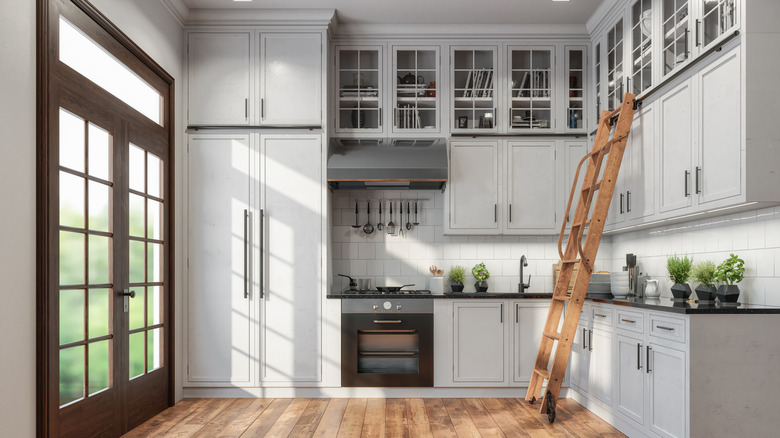The Practical Reasons Your Kitchen Cabinets Don't Extend All The Way To The Ceiling
Whether you're designing a new kitchen or considering a remodel, you might be debating extending your cabinets all the way to the ceiling. Many homeowners are choosing to do this for the extra storage space and streamlined aesthetic, among other benefits. However, there are some practical reasons why not all kitchens have floor-to-ceiling cabinetry: mold (and mildew) prevention and safety.
Brandy Rinehart, an interior designer at Habitar Design in Chicago, Illinois, told Daily Meal that it costs more to install custom cabinets that reach the ceiling. That higher cost comes from the extra materials needed and complex installation process, but those aren't the only reasons this is a pricey kitchen upgrade that's not worth it. The main reasons to maintain space between your cabinets and the ceiling are 1) the additional ventilation that prevents mold and mildew buildup, and 2) a reduced risk of falling while reaching for top-shelf items. Let's dive deeper into the benefits of traditional upper cabinets and explore how floor-to-ceiling cabinetry can be problematic for homeowners.
Shorter cabinets prevent mold and mildew growth with improved airflow
Cooking requires heat, whether you're baking a cake in the oven or boiling water on the stovetop, and that heat (along with any related steam or smoke) will rise toward the ceiling. You also generate heat in your kitchen when you wash dishes by hand or in the dishwasher. When there's space between the top of the cabinets and the ceiling, it acts as ventilation for that area. The hot air can move around freely, allowing dampness and moisture to escape rather than linger. Also, the free airflow prevents emissions from cooking appliances — like carbon monoxide and other toxins — from accumulating.
When that space is enclosed with extra cabinets, though, the hot air (and steam, smoke, etc.) can slip through the smallest cracks between the cabinets, ceiling, and doors, where it then becomes trapped. These cracks can develop as the wood contracts and expands with temperature and humidity fluctuations. Poor ventilation like this can lead to mold and mildew buildup, which is not only damaging for the cabinets themselves but also a potential health risk for you and your family. That's why, if your kitchen cabinets already extend to the ceiling and you see mold or mildew building up anywhere inside, you should take this as one of the signs that your kitchen is in desperate need of remodeling.
Shorter cabinets reduce the risk of falling while reaching for items
Believe it or not, people's average height plays a part in how high contractors build kitchen cabinets. Keeping everyday items — like plates, cups, pots, and pans — at an easy-to-grab height means you don't have to pull out a stepladder or stool, thus reducing your risk of falling while preparing and cooking meals. To accommodate this, contractors keep cabinets at a height that leaves space between them and the ceiling. As designer Ashley Noethe told Normandy, "At a certain point, there's no benefit to going higher because you'll need more than just a stepladder to reach anything you store there. It's better to keep things more accessible."
We do acknowledge that, even with space left between the cabinets and ceiling, you might need a stepladder or stool to reach the top shelf if you have mobility issues or are shorter than the average person. Still, at least you won't have to set up a full-fledged ladder like you would if your cabinets used all of the open space up to your ceiling. If you're looking to make the most of minimal kitchen cabinet space, though, you can still utilize the empty room above your cabinets for storing bulky, fragile, and seasonal items that you only use occasionally. Or, use it purely for decoration and displaying special collectible items.


